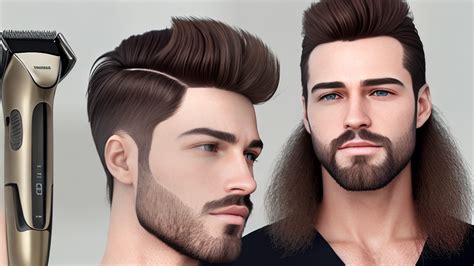What Are Male Hair Units?
Male hair units, also known as hairpieces or toupees, are artificial hairpieces designed to conceal hair loss or thinning hair. They come in various materials, styles, and construction techniques to cater to diverse preferences and scalp conditions.

Types of Male Hair Units
1. Lace Front Hair Units
- Utilizes a sheer lace base that blends seamlessly with the scalp
- Creates a natural hairline and allows for styling versatility
- Typically more expensive than other types
2. Skin Base Hair Units
- Made with a polyurethane or silicone base that conforms to the scalp’s shape
- Provides a secure hold and conceals any bald patches
- Less breathable than lace front units
3. Monofilament Hair Units
- Constructed with thin, synthetic fibers that create the illusion of hair growing from the scalp
- Allows for more natural movement and ventilation
- Can be more delicate than other types
Benefits of Male Hair Units
- Conceals hair loss: Provides an immediate solution for thinning or balding areas.
- Enhances appearance: Improves self-esteem and confidence by restoring a fuller head of hair.
- Versatile styling: Allows for various hair lengths, colors, and styles to match personal preferences.
- Low-maintenance: Requires less time and effort for styling and grooming compared to natural hair.
Considerations for Choosing a Male Hair Unit
1. Base Material: Choose a base that provides the desired level of naturalness, breathability, and durability.
2. Hair Type: Opt for hair that closely resembles the texture, color, and density of your natural hair.
3. Construction Method: Select a construction method that aligns with your lifestyle and budget, considering factors such as breathability, security, and styling options.
Common Mistakes to Avoid
- Choosing a Poor-fitting Unit: Ensure the unit fits snugly to prevent slippage or discomfort.
- Over-styling: Excessive heat or chemical treatments can damage the hairpiece.
- Neglecting Maintenance: Regular cleaning and storage are crucial for prolonging the unit’s lifespan.
- Concealing Improperly: Avoid wearing units that are too noticeable or create unnatural-looking hairlines.
How to Apply a Male Hair Unit
Step 1: Prepare the Scalp
- Wash and dry your scalp thoroughly.
- Remove any excess hair or product buildup.
Step 2: Apply Adhesive
- Use a specialized hair unit adhesive and apply it thinly to the base of the unit.
- Wait for the adhesive to become tacky.
Step 3: Position the Unit
- Gently align the unit with your hairline and press it into place.
- Use a hairdryer or heating tool to activate the adhesive and secure the unit.
Step 4: Trim and Style
- Trim any excess hair around the edges of the unit to blend it seamlessly.
- Style the hair to your desired length and volume.
Male Hair Units by the Numbers
- According to the American Hair Loss Association, an estimated 50% of men over the age of 50 will experience significant hair loss.
- The global market for male hair units is projected to reach $1.5 billion by 2025.
- A study conducted by University of California, San Francisco revealed that men who wore hair units experienced a significant increase in self-esteem and social acceptance.
Future Applications of Male Hair Units
- Advanced Materials: The development of new materials such as nanofibers and biopolymers could improve breathability, comfort, and longevity.
- Artificial Intelligence Hairpieces: AI-powered units could offer personalized recommendations for hair unit selection, styling, and maintenance.
- Rapid Attachment and Removal: Researchers are exploring innovative attachment methods that allow for quick and effortless application and removal of hair units.
Useful Tables
Table 1: Types of Male Hair Units
| Type | Base Material | Benefits | Drawbacks |
|---|---|---|---|
| Lace Front | Sheer lace | Natural hairline, versatility | Expensive, less breathable |
| Skin Base | Polyurethane/silicone | Secure hold, conceals bald patches | Less breathable, less realistic |
| Monofilament | Thin synthetic fibers | Natural movement, ventilation | Delicate, requires careful handling |
Table 2: Factors to Consider When Choosing a Male Hair Unit
| Factor | Considerations |
|---|---|
| Base Material | Naturalness, Breathability, Durability |
| Hair Type | Texture, Color, Density |
| Construction Method | Security, Styling Options, Maintenance |
Table 3: Common Mistakes to Avoid When Using Male Hair Units
| Mistake | Consequences |
|---|---|
| Poor Fit | Slippage, Discomfort |
| Over-Styling | Damage to Hairpiece |
| Negligence | Premature Wear and Tear |
| Improper Concealment | Unnatural Appearance |
Table 4: Future Applications of Male Hair Units
| Application | Benefits |
|---|---|
| Advanced Materials | Improved Breathability, Comfort, Longevity |
| Artificial Intelligence Hairpieces | Personalized Recommendations, Maintenance |
| Rapid Attachment and Removal | Ease of Application and Removal |
